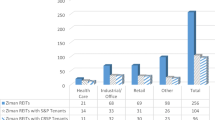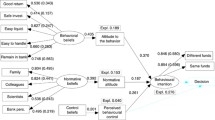Abstract
Recent research has suggested that individual share investors fall into a number of groups with distinct preferences for particular share characteristics. The majority are relatively risk-averse and seek stable investments. An important source of advice for these investors is their stockbroker. But, how well do stockbrokers understand their clients' attitudes and preferences? The present paper suggests that retail stockbrokers overestimate their clients' willingness to take risk and to invest in more speculative stocks. As on-line stockbroking is providing significant competition to the traditional full-service broker, stockbrokers must understand their clients' needs. If this is not the case, it may be difficult for retail stockbrokers to give appropriate advice or for a fruitful adviser–client relationship to be established.


Similar content being viewed by others
References
Australian Stock Exchange Ltd. ‘Australia's share owners: An ASX study of share investors in 2004’, 2005 [cited 25th August, 2005]; available from http:\\www.asx.com.au.
Too many poor plans. Choice, 2003 January/February, pp. 8–15.
Diacon, S. (2004) ‘Investment risk perceptions: Do consumers and advisers agree?’, International Journal of Bank Marketing, Vol. 22, No. 2/3, pp. 180–198.
Financial Services Reform Amendment Act. (2003), Commonwealth of Australia.
Evensky, H. (1997) ‘Risk is a four-letter word’, Journal of Financial Planning, Vol. 10, No. 5, pp. 74–82.
Kinder, G. D. (1996) ‘The seven stages of money maturity’, Journal of Financial Planning, Vol. 9, No. 6, pp. 36–37.
Vessenes, P. M. (2005) ‘Uncovering the Demons in the sales process’, Journal of Financial Planning, Vol. 18, No. 8, pp. 32–34.
Katz, D. B. (1995) ‘To some clients, long term is a green banana’, National Underwriter, 3rd April, p. 8.
Nowka, C. L. and Gottfurcht, J. W. (2000) ‘The psychology of money, the psychologist and the financial planner’, Journal of Financial Planning, Vol. 13, No. 1, pp. 100–103.
Rattiner, J. H. (2005) ‘‘Fiduciary’: One word, many views’, Journal of Financial Planning, Vol. 18, No. 11, pp. 38–44.
Clark-Murphy, M. and Soutar, G. N. (2004) ‘What individual investors value: Some Australian evidence’, Journal of Economic Psychology, Vol. 25, No. 4, pp. 539–555.
Clark-Murphy, M. and Soutar, G. N. (2005) ‘Individual investors' preferences: A segmentation analysis’, Journal of Behavioral Finance, Vol. 6, No. 1, pp. 6–14.
Australian Companies & Securities Legislation. Cwlth; 1991.
Statman, M. (1995) ‘Behavioral finance versus standard finance’, in Wood, A. S. (ed) ‘Behavioural Finance and Decision Theory in Investment Management’, Association of Investment Management and Research, Charlottesville.
Ioannides, K. K. (1994) ‘Client snapshots give you needed information’, Best's Review, August, p. 54.
Drucker, D. J. (2005) ‘Inner Knowledge: ‘You can't build relationships if clients don't recognize the value you bring’’, Financial Planning, June 1, p. 1.
Mellan, O. (2004) ‘Emotional rescue’, Investment Advisor, August, p. 68.
Johnson, K. (1994) ‘Discovering your client's spending personality’, Broker World, Vol. 14, No. 8, pp. 80–82, 140, 4.
Melchinger, J. H. (1995) ‘Attracting the affluent’, Broker World, Vol. 15, No. 3, pp. 100–108, 36.
Kahan, S. (1999) ‘Investment planning: The broker/dealer factor’, The Practical Accountant, January 1, pp. 34–36.
Lazo, J. K., Kinnell, J. C. and Fisher, A. (2000) ‘Expert and layperson perceptions of ecosystem risk’, Risk Analysis, Vol. 20, No. 2, pp. 179–193.
Margolis, H. (1996) ‘Dealing with Risk: Why the Public and the Experts Disagree on Environmental Issues’, University of Chicago Press, Chicago.
Wright, G., Pearman, A. and Yardley, K. (2000) ‘Risk perception in the U.K. oil and gas production industry: Are expert loss-prevention managers' perceptions different from those of members of the public?’, Risk Analysis, Vol. 20, No. 5, pp. 681–690.
Gutteling, J. M. and Kuttschreuter, M. (2002) ‘The role of expertise in risk communication: Laypeople's and expert's perception of the millennium bug risk in The Netherlands’, Journal of Risk Research, Vol. 5, No. 1, pp. 35–47.
Pollack, R. A. (1995) ‘Regulating risks’, Journal of Economic Literature, Vol. 33, No. 1, pp. 179–191.
Pollack, R. A. (2001) ‘Imagined risks and cost–benefit analysis’, American Economic Review, Vol. 88, No. 2, pp. 376–380.
Kahneman, D., Slovic, P. and Tversky, A., (eds) (1982) ‘Judgement under Uncertainty: Heuristics and Biases’, Cambridge University Press, Cambridge.
Shefrin, H. (2000) ‘Beyond Greed and Fear’, Harvard Business School Press, Boston.
Sjöberg, L. (2001) ‘Limits of knowledge and the limited importance of trust’, Risk Analysis, Vol. 21, No. 1, pp. 189–198.
Leder, G. (2004) ‘From salesperson to advisor: Going from the first role to the second demands that clients trust you’, On Wall Street, September, p. 1.
Clark-Murphy, M., Kristofferson, I. and Gerrans, P. (2002) ‘What makes superannuation decisions difficult?’, International Journal of Business Studies, Vol. 10, No. 1, pp. 73–94.
Baron, J., Hershey, J. C. and Kunreuther, H. (2000) ‘Determinants of priority for risk reduction: The role of worry’, Risk Analysis, Vol. 20, No. 4, pp. 413–427.
Roszkowski, M. J. and Grable, J. E. (2005) ‘Gender stereotypes in advisors' clinical judgments of financial risk tolerance: Objects in the mirror are closer than they appear’, Journal of Behavioral Finance, Vol. 6, No. 4, pp. 181–191.
Australian Shareholders' Association. (1999) ‘Share the Advantages of ASA Membership’ [Brochure]. Australian Shareholders' Association, Sydney.
Green, P. E. and Srinivasan, V. (1990) ‘Conjoint analysis in marketing: New developments with implications for research and practice’, Journal of Marketing, Vol. 54, pp. 3–19.
Barberis, N. and Thaler, R. (2002) ‘A survey of behavioral finance’, Working Paper No. w9222, National Bureau of Economic Research. Cambridge, MA.
Gerrans, P., Gardner, D., Clark-Murphy, M. and Speelman, C. (2006) ‘An investigation of home bias in superannuation investment choices’, Economic Papers, Vol. 25, No. 1, pp. 17–31.
Dreman, D. N. and Berry, M. A. (1995) ‘Overreaction, underreaction, and the low-p/e effect’, Financial Analysts Journal, Vol. 51, No. 4, pp. 21–30.
Hair Jr., J. F., Anderson, R. E., Tatham, R. L. and Black, W. C. (1995) ‘Multivariate Data Analysis with Readings’, Simon & Schuster, Englewood Cliffs.
Johnson, R. M. (1977) ‘Multiple discriminant analysis: Marketing research applications’, in Sheth, J. N. (ed) ‘Multivariate Methods for Market and Survey Research’, AMA, Chicago.
Peterson, R. A. and Mahajan, V. (1976) ‘Practical significance and partitioning variance in discriminant analysis’, Decision Sciences, Vol. 7, pp. 649–658.
Dobbie, M. (1998) ‘Why clients hate stockbrokers’, Personal Investment, December, pp. 48–53.
Hepworth, A. and Clegg, B. (2000) ‘High-flyers can only stand and watch’, Australian Financial Review, April 6, Sect. 3.
Jolliffe, A. (2005) ‘Brokers urged to go the extra mile’, Financial Times, August 13, Sect. 23.
Ackermann, M. (2005) ‘Wire houses seen hurt in independent advice push’, American Banker, August 1, p. 6.
Hawksley, F. (1992) ‘Stockbrokers: Still willing and eager’, Accountancy, October, p. 54.
Eisingerich, A. B. and Bell, S. J. (2006) ‘Relationship marketing in the financial services industry: The importance of customer education, participation and problem management for customer loyalty’, Journal of Financial Services Marketing, Vol. 10, No. 4, pp. 86–97.
Allen, F. and Gale, D. (1999) ‘Innovations in financial services, relationships and risk sharing’, Management Science, Vol. 45, No. 9, pp. 1239–1253.
Ennew, C. and Hartley, M. (1996) ‘Financial advisers and savings and investment products’, in Buttle, F. (ed) ‘Relationship Marketing: Theory and Practice’, Paul Chapman Publishing, London.
Author information
Authors and Affiliations
Appendix
Rights and permissions
About this article
Cite this article
Clark-Murphy, M., Soutar, G. Do retail stockbrokers understand clients' investment preferences?. J Financ Serv Mark 13, 135–149 (2008). https://doi.org/10.1057/fsm.2008.11
Received:
Revised:
Published:
Issue Date:
DOI: https://doi.org/10.1057/fsm.2008.11




